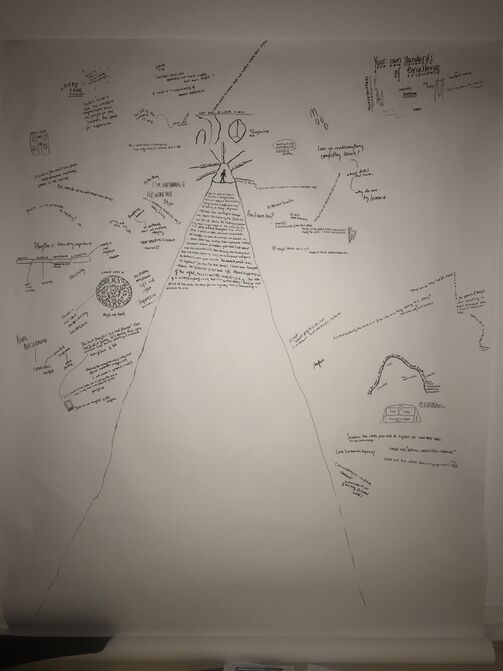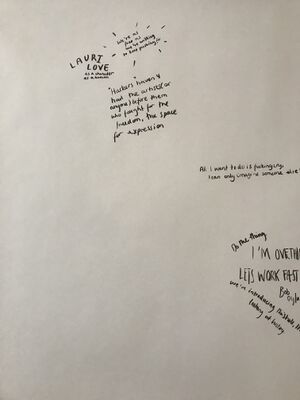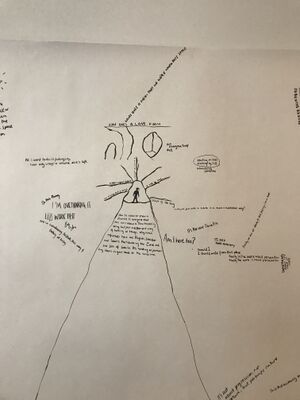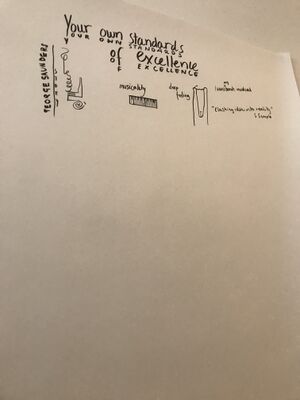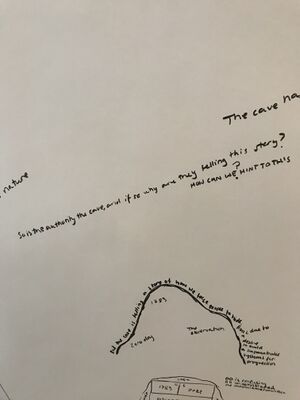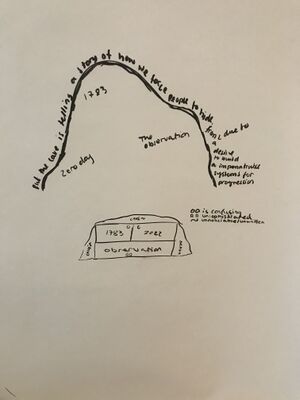TextOnPRACTICE(1stDraft): Difference between revisions
No edit summary |
No edit summary |
||
| (5 intermediate revisions by the same user not shown) | |||
| Line 1: | Line 1: | ||
''NOTE: I reference Tom Sachs here alot, this was written before the Curbed article which documented that his studio environment was very unhealthy.'' | |||
I've been making what I call '''wall writings''', although I'd like to come up with a better name. As it exists now, these are large rolls of paper which are 2m wider. I '''roll the paper out to just over my head''', and I stick this to the wall (with double sided adhesive that doesn't take off the paint on the wall). On these scrolls of paper '''I practice a number of things: free writing, jotting down ideas on the go, drawing images from curren work/future work, writing in shapes/word art. long form essystic writing, fears/ worries, mapping, recurring questions, catloguing feedback, drawing shapes of narratives etc.''' All of these activities come together '''to form a kind of map.''' [[File:Wall Drawing.jpg|thumb|671x671px|Picture of Wall]] | |||
[[File:Wall Writing 3.jpeg|thumb]] | |||
This has become '''a way of tracking the progression of thoughts, of eliciting connections, of moving whilst making, of making non-digital work, forming images through words'''. It '''stems also from a desire or frustration of communicating connections and ideas''' I have. It is also a form of '''simple self expression.''' | |||
I am currently '''only writing in black ink on white paper.''' I use '''specific pens which have a soft felt tip''', they give an '''inky feel'''. '''I stand, squat or sit on the floor''' (this is very important). I have '''not cut the paper yet''', but '''I do intend for there to be an end to this wall writing.''' Then I will begin another. '''I am editing but showing the edits, making them visable'''. Often if I find myself chastisitng myself on the page I will edit this '''to be kinder, to be more open, more accepting.''' I would like to create a rolling paper machine, from hand inspired by the artist '''Van Neistat''', he replied to an email I sent him and told me how to make it. | |||
A key start for this was also my attempts at '''"creating my own standards of excellence"''' (tom sachs), and '''protocals to help me function as a working artist'''. A key thing is I want to '''develop my own aesthic standards of excellene i.e. the detalis and quality of the image, sound, performance etc.''' | |||
I make this because '''it makes me feel good''', '''it allows me to function and be.''' When I am engaging in this practice, I feel my experience of life is more continous, it 'flows. When I don't, life is a bit more staccato and can feel draining. | |||
There is always a '''desire to build maps''', perhaps an influence of '''cartography''' even. Even more, the presence of '''non-linear ways of representing ideas or telling stories''' continues to be important. | |||
[[File:Wall Writing | [[File:Wall Writing 4.jpeg|thumb]] | ||
This new work has a very direct link to the previous work, as '''it kind of acted like a Zero Draft for the project''' (note to self get reference to what I mean by Zero Draft). I have been thinking about Zero Drafts, and different ways of screen writing since my Bachelors were I studied '''screen-wiring in a a very conventional way'''. I found it restrictive, '''cheesy and dull.''' '''Reducing the text''' down to a '''series of instructions''', this '''seemed to me to be the very last step''' and to try '''to actually write''' in this format was very much '''restrictive.''' | |||
I will write a list of my influences so far: | |||
[[File:Wall Writing 2.jpeg|thumb]] | |||
'''Tom Sachs''' (for his processes and ways of working, specifically '''10 bullets''', '''Grayon Perry's''' (the way he uses mapping and cartogrpahy in his illustration specifically thinking of one I saw in a gallery in Eastbourne, its called '''Map of Nowhere'''), '''Olga Tokarczuk''' (her writing from above, the way she uses maps in her novels and images - non linear, and not just associative, particularly in '''Book of Jacobs'''), '''Pina Baush''' (for movement, for image), '''Sayaka Murata''' (for the unapolgetic personal standards of her abusrifity, '''mainly her interviews'''), '''Iain Mcgilchrist''''s (writing and philosophical approach to mind and mystery), '''Karl Diesserioth''' (for the way he writes and talks about the mind and emotion), '''Tarkovsky''' (it is not linear for sure, nor is it Freudian or Assiociative but he makes his own perspective). There is also a strong influence of '''medieval word art,''' Cihad has also shown me some examples from historical Arabic word art. '''George Saunders''' is another influence of mine, particuarly his book on writing: '''A Swim in The Pond In the Rain'''. I also am influenced by '''Kendrick Lamar'''<nowiki/>'s way of telling stories, specifically in a track called '''FEAR. Andre 3000 verse on Blonde (Solo (Reprise), the stream of consciousness, flipping along time.''' It is a story which takes place across generations, with the character of Fear being the link between all the stories. In '''general storytelling in music, most present in''' '''hip-hop and folk music''' has always been a key influence. '''Mamoru Oshii''' the way they deal with moments in their films. '''Julie Mehretu''', for the way they work with lines and general visual approach, see her album cover for Pharo Sanders and Flosting points, '''Congress''' and her show title '''<nowiki/>'A UNIVERSAL HISTORY OF EVERYTHING AND NOTHING'.''' | |||
[[File:Wall Writing 5.jpeg|thumb|Wall Writing 5]] | |||
'''I am trying to''' '''remove how central the finished work is to my practice, these works are destination where I arrive at, I circle, I return to but they are contained and do not exist without the roads that lead me there, and the roads that don't.''' '''It helps to stop thinking in a 'I need to make a thing' head space - this removes the play element, and thinking in such a way is quite deadening and disheartening to me.''' | |||
'''There is also a desire to not just write for the sake of it.''' The word productive is often deemed a dirty word and in some contexts I agree, but '''I want my writing to be something that aids, that it helpful, perhaps it guides or holds me up in some way.''' | |||
'''My reading habits are, I read novels and short stories, I listen to anything non fiction or critical (often podcast or conversations of some kind, or a short lecture or lecture series, and audiobooks), I've always engaged with maps and am intrigued by them. I am pulled along by story and "beauty" and function.''' | |||
'''Function''', this is an important concept in my practice - '''a relatively new concept'''. I have begun to '''understand and perhaps even respect the part of myself that likes to make and study system, to be pulled into understanding how something functions - what the processes are, under the hood.''' | |||
With all this said. '''I also deeply respect mystery and to not look at the finger pointing to the moon, but the moon itself.''' It's a balance of '''creating processes and understanding how my practice functions whilst also remember that not everything is understood or reduced down to functions, that there is always a slither of the infinite that surrounds a work which moves me.''' | |||
It is important to note that '''my desire to create protocols and standards for myself as an artist came from a commitment to the profession of being an artist.''' This is something which is of course important to me on a foundational level, ''''the basement that allows the rest of my life to function'''' (interview from louissna, writer of the postcard, Anne Berest) but also '''this is what I will do for my work and there is something very serious about this.''' '''I have to find a way to make it stable, something that I can come to every day. I need some kind of map then.''' | |||
The idea of creating '''"your own standards of excellence"''' has been so important in arriving at a lot of these ideas above. '''There is some trust that needs to happen'''. | |||
'''How to be a working artist?''' Is a question I've asked myself Over and Over. | |||
There is also this desire to '''execute the images and the aesthetics by these standards I make for myself.''' '''It must come from my own standards''', this I think ensure that the core of the work is radiating some energy somehow, rather follwing someone else's standards in a very literal and methodical way perhaps draws the artist away from their core. It must be you. The concept of you. Whatever this means. As an artist you can drift towards someone with superior skill what does this mean? This sometimes can be great, it's called collaboration but how to keep the core of the work? | |||
[[File:Wall Writing 6.jpeg|thumb|Wall Writing 6|center]] | |||
NOTES FROM YESTERDAY | NOTES FROM YESTERDAY | ||
Latest revision as of 17:12, 18 March 2023
NOTE: I reference Tom Sachs here alot, this was written before the Curbed article which documented that his studio environment was very unhealthy.
I've been making what I call wall writings, although I'd like to come up with a better name. As it exists now, these are large rolls of paper which are 2m wider. I roll the paper out to just over my head, and I stick this to the wall (with double sided adhesive that doesn't take off the paint on the wall). On these scrolls of paper I practice a number of things: free writing, jotting down ideas on the go, drawing images from curren work/future work, writing in shapes/word art. long form essystic writing, fears/ worries, mapping, recurring questions, catloguing feedback, drawing shapes of narratives etc. All of these activities come together to form a kind of map.
This has become a way of tracking the progression of thoughts, of eliciting connections, of moving whilst making, of making non-digital work, forming images through words. It stems also from a desire or frustration of communicating connections and ideas I have. It is also a form of simple self expression.
I am currently only writing in black ink on white paper. I use specific pens which have a soft felt tip, they give an inky feel. I stand, squat or sit on the floor (this is very important). I have not cut the paper yet, but I do intend for there to be an end to this wall writing. Then I will begin another. I am editing but showing the edits, making them visable. Often if I find myself chastisitng myself on the page I will edit this to be kinder, to be more open, more accepting. I would like to create a rolling paper machine, from hand inspired by the artist Van Neistat, he replied to an email I sent him and told me how to make it.
A key start for this was also my attempts at "creating my own standards of excellence" (tom sachs), and protocals to help me function as a working artist. A key thing is I want to develop my own aesthic standards of excellene i.e. the detalis and quality of the image, sound, performance etc.
I make this because it makes me feel good, it allows me to function and be. When I am engaging in this practice, I feel my experience of life is more continous, it 'flows. When I don't, life is a bit more staccato and can feel draining.
There is always a desire to build maps, perhaps an influence of cartography even. Even more, the presence of non-linear ways of representing ideas or telling stories continues to be important.
This new work has a very direct link to the previous work, as it kind of acted like a Zero Draft for the project (note to self get reference to what I mean by Zero Draft). I have been thinking about Zero Drafts, and different ways of screen writing since my Bachelors were I studied screen-wiring in a a very conventional way. I found it restrictive, cheesy and dull. Reducing the text down to a series of instructions, this seemed to me to be the very last step and to try to actually write in this format was very much restrictive.
I will write a list of my influences so far:
Tom Sachs (for his processes and ways of working, specifically 10 bullets, Grayon Perry's (the way he uses mapping and cartogrpahy in his illustration specifically thinking of one I saw in a gallery in Eastbourne, its called Map of Nowhere), Olga Tokarczuk (her writing from above, the way she uses maps in her novels and images - non linear, and not just associative, particularly in Book of Jacobs), Pina Baush (for movement, for image), Sayaka Murata (for the unapolgetic personal standards of her abusrifity, mainly her interviews), Iain Mcgilchrist's (writing and philosophical approach to mind and mystery), Karl Diesserioth (for the way he writes and talks about the mind and emotion), Tarkovsky (it is not linear for sure, nor is it Freudian or Assiociative but he makes his own perspective). There is also a strong influence of medieval word art, Cihad has also shown me some examples from historical Arabic word art. George Saunders is another influence of mine, particuarly his book on writing: A Swim in The Pond In the Rain. I also am influenced by Kendrick Lamar's way of telling stories, specifically in a track called FEAR. Andre 3000 verse on Blonde (Solo (Reprise), the stream of consciousness, flipping along time. It is a story which takes place across generations, with the character of Fear being the link between all the stories. In general storytelling in music, most present in hip-hop and folk music has always been a key influence. Mamoru Oshii the way they deal with moments in their films. Julie Mehretu, for the way they work with lines and general visual approach, see her album cover for Pharo Sanders and Flosting points, Congress and her show title 'A UNIVERSAL HISTORY OF EVERYTHING AND NOTHING'.
I am trying to remove how central the finished work is to my practice, these works are destination where I arrive at, I circle, I return to but they are contained and do not exist without the roads that lead me there, and the roads that don't. It helps to stop thinking in a 'I need to make a thing' head space - this removes the play element, and thinking in such a way is quite deadening and disheartening to me.
There is also a desire to not just write for the sake of it. The word productive is often deemed a dirty word and in some contexts I agree, but I want my writing to be something that aids, that it helpful, perhaps it guides or holds me up in some way.
My reading habits are, I read novels and short stories, I listen to anything non fiction or critical (often podcast or conversations of some kind, or a short lecture or lecture series, and audiobooks), I've always engaged with maps and am intrigued by them. I am pulled along by story and "beauty" and function.
Function, this is an important concept in my practice - a relatively new concept. I have begun to understand and perhaps even respect the part of myself that likes to make and study system, to be pulled into understanding how something functions - what the processes are, under the hood.
With all this said. I also deeply respect mystery and to not look at the finger pointing to the moon, but the moon itself. It's a balance of creating processes and understanding how my practice functions whilst also remember that not everything is understood or reduced down to functions, that there is always a slither of the infinite that surrounds a work which moves me.
It is important to note that my desire to create protocols and standards for myself as an artist came from a commitment to the profession of being an artist. This is something which is of course important to me on a foundational level, 'the basement that allows the rest of my life to function' (interview from louissna, writer of the postcard, Anne Berest) but also this is what I will do for my work and there is something very serious about this. I have to find a way to make it stable, something that I can come to every day. I need some kind of map then.
The idea of creating "your own standards of excellence" has been so important in arriving at a lot of these ideas above. There is some trust that needs to happen.
How to be a working artist? Is a question I've asked myself Over and Over.
There is also this desire to execute the images and the aesthetics by these standards I make for myself. It must come from my own standards, this I think ensure that the core of the work is radiating some energy somehow, rather follwing someone else's standards in a very literal and methodical way perhaps draws the artist away from their core. It must be you. The concept of you. Whatever this means. As an artist you can drift towards someone with superior skill what does this mean? This sometimes can be great, it's called collaboration but how to keep the core of the work?
NOTES FROM YESTERDAY
To address:
- Writing on the wall - Medieval Word Art - Non-linear approaches - How to make this way of writing as generous to the reader as possible? - Ten Bullets i.e. protocols and practicalities in your practice

